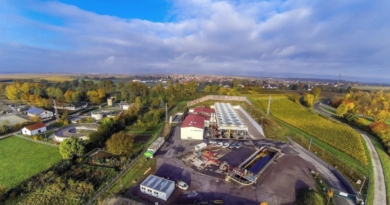Kruonis will have one of the most modern remote solar parks in Lithuania
For many years the town of Kruonis in Kaišiadorys district has been famous throughout Lithuania by hydroelectric power plant. Kruonis will soon be famous having one of the most modern solar power parks in the country. Although the entrepreneurs developing the park Audrius Šaltenis and Artūras Kerševičius have not yet come up with the name of the future solar power plant park, it is already clear that the new object should be built this year. Artūras Kerševičius, co-owner of UAB Bevielės technologijos talks about the project and future plans.
Why will a park managed by your company appear in Kruonis?
There were many reasons. First of all, I myself come from the Kaišiadorys region. Although the company’s office is in Kaunas, I currently live in Stasiūnai, I like to joke that I live right here, behind the hill from Kaišiadorys. What’s more, my wife and I are going to build a house on a plot in Ąžuolynas quarter, because I see that this is a promising place for both a young family and business. Therefore, it is not surprising that I settle in Kaišiadorys, and we are building our park in Kruonis.
As a very significant reason why the project will be developed in Kaišiadorys district, I can also point out that three years ago we used the municipal business promotion measure. In order to take advantage of the opportunities, I filled out the application and was invited to meet the jury. My idea received almost a maximum of 2,500 Eur of support, which was especially useful in the technology testing phase. This is a very important tool for municipal business support, so on behalf of the company, we thank the authors of the idea.
Another important aspect: the municipality took our project very positively, issued a permit to build a park, and arranged the documents related to the change of land use. Focusing on business needs is also an important factor in deciding where to invest.
Tell us a little more about the project. What capacity should the park be?
For the time being, 1 MW remote solar power plant will be built on a 2 ha plot a park in Kruonis. But it is possible that we will not stop here. We will see how our business model works, what challenges and opportunities open up for the world, and for Europe in particular, as we move more boldly towards renewable energy.
Having already talked about the business model, could you share what it is?
Of course, I don’t see much of a secret here. We focus on remote manufacturing consumers (businesses) who do not have the ability to build a power plant on their roofs. Those companies can apply for an APVA (Environmental Project Management Agency) subsidy to recover 30% of the cost of acquiring a remote solar power plant. That means that the average return on investment for companies is 6-7 years. When the investment pays off, businesses produce electricity for free, only paying a certain fee for using ESO networks.
Sounds appealing. Perhaps the focus on the business segment also determines the need to focus on high quality?
Of course. We strive for high quality in a variety of ways. For example, while solar power plants are a fairly environmentally friendly solution as they allow the produce electricity from renewable sources, but we are not limited to that. Our park will feature Bifacial double-sided glass-to-glass solar modules that stand out for their durability and efficiency. Such modules allow to produce by 10 percent more energy compared to conventional modules, and when it comes time to dispose of them due to their unique silicon-based base, such modules will be recyclable. However, that day will only come after 30 years, and the payback, as I said, is 6-7 years, so the remaining 23-24 years our customers will only pay for the use of ESO networks. This is a very promising path that will either reduce production costs and allow a cheaper product to be delivered to the consumer, or will allow for an increase in profit margins. Both options entice our customers.
Briefly explain why your park can be called one of the most modern in Lithuania.
Smart IoT (Internet of Things) solutions for monitoring of solar power plant operating parameters (meteorological data, module performance, module dust) will be implemented in Kruonis Solar Park. That will allow timely detection of faults, responsible persons will get notifications and eliminate problems in time. Time, especially in summer, is a critical factor, even one hour of downtime can bring thousands of losses to our customers. As all the necessary data will be stored in the cloud, they are instantly available to the solar park service company and our customers via the WEB interface. Current solar park monitoring systems, which are developed by inverter manufacturers, do not adequately address all of these issues.




